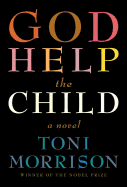
| Publisher: | Knopf | |
| Genre: | Fiction, Contemporary Women, Literary, African American, Magical Realism | |
| ISBN: | 9780307594174 | |
| Pub Date: | April 2015 | |
| Price: | $24.95 |
| Starred | Fiction |
by Toni Morrison
Toni Morrison (Home), winner of a Pulitzer and a Nobel Prize in Literature, satisfies her fans with a searing, lyrical story about the power of childhood trauma.
God Help the Child centers on a woman who has left behind the "dumb countryfied name" Lula Ann to become Bride, "with nothing anybody needs to say before or after that one memorable syllable," a successful California career woman with her own cosmetics line who wears no makeup. Her mother was a light-skinned, "high yellow" woman dismayed by and unable to love her blue-black daughter, but Bride grows up to repossess her skin tone and every other aspect of her beauty.
From a childhood marked by rejection and terrible crimes, Bride remakes herself as an object of attraction and a financial success, but as the novel opens, she faces dual blows: her mysterious live-in boyfriend, Booker, leaves, and a prisoner is paroled with whom she shares an old bond. As Bride's journey acquires a momentum of its own, the magnetism of her troubles pulls the reader along. In the end, healing comes in a surprising form.
Beautifully composed in a variety of distinct voices and covering a range of family concerns, God Help the Child employs a hint of magical realism and explores issues of race and women's lives familiar to fans of Morrison's fiction. The story of Bride's life and trials is sensual, both delicate and strong, poetic and heavy with sex, love and pain, exemplifying a revered author's unfailing talent. --Julia Jenkins, librarian and blogger at pagesofjulia
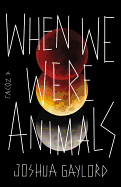
| Publisher: | Mulholland Books | |
| Genre: | General, Gothic, Fiction, Coming of Age, Thrillers, Magical Realism | |
| ISBN: | 9780316297936 | |
| Pub Date: | April 2015 | |
| Price: | $26 |
| Fiction |
by Joshua Gaylord
In When We Were Animals, Joshua Gaylord (Hummingbirds), who has also written horror novels under the pen name Alden Bell, has managed to craft a werewolf story without any werewolves. Instead, the novel focuses on much more frightening creatures: teenagers.
When We Were Animals is set in a small Midwestern town where adolescents spend a formative year or two running wild. In an unexplained phenomenon tied to the cycles of the moon, they are compelled to shed their clothes and roam the streets in semi-feral packs. It's an excellent, disturbing premise that whittles the werewolf story down to the potent question at its heart: Are humans truly distinct from our animal ancestors?
Gaylord's protagonist, Lumen Fowler, is caught between her family's upstanding reputation--her mother, Lumen is told, never ran wild--and a Thoreau-like determination to revel in life's primitive joys. Her perspective jumps backward and forward in time, bouncing between her adolescence--spent jealously watching her friends "breach" (Gaylord's term for the phenomenon) before finally undergoing the process herself--and her stultified adulthood as an ambivalent wife and mother. The book is largely plotless, embracing a meditative mode enhanced by superb prose.
Gaylord has taken bits and pieces from horror, young adult fiction and literary classics along the lines of Joseph Conrad's Heart of Darkness to create Lumen's world. Lumen herself, though, is easily the most impressive component. Under her spell, even the most staid reader would feel the impulse to run wild. --Hank Stephenson, bookseller, Flyleaf Books
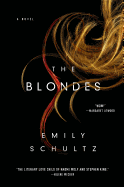
| Publisher: | Thomas Dunne Books | |
| Genre: | Suspense, Fiction, Satire, Thrillers, Literary | |
| ISBN: | 9781250043351 | |
| Pub Date: | April 2015 | |
| Price: | $25.99 |
| Fiction |
by Emily Schultz
In a near-future existence, Hazel Hayes, a young grad student living in New York City, witnesses firsthand that a terrifying malady is afflicting both naturally and bleached-blonde women worldwide. They are transmitting amongst themselves a strange illness of unknown origins, one that causes them to perform acts of extreme violence. While wrestling with the physical and emotional difficulties of an unwanted pregnancy, the result of an affair with her married professor, Hazel shares her thoughts on the rapidly changing world with her unborn child, and she navigates their now treacherous environment, in which blonde women can suddenly go crazy, killing and maiming those nearby, and passing the infection to others like them.
Fast-paced drama, punctuated with humor, leads readers through the bizarre events of Emily Schultz's The Blondes. This is an odd world where all women with hair even remotely resembling blonde--including those with shades closer to red--are soon harassed, persecuted and interned by governments around the world. By using this strange disease, which appears rapidly in otherwise visibly healthy women, Schultz (Heaven Is Small) writes a subtle commentary on how discrimination operates around the globe. She has masterfully twisted the known with the unknown into a disconcerting story, together with Hazel's deep personal reflections on her unplanned pregnancy. Schultz plays on fears that lurk inside people when confronted with something alien and dangerous, and shows how the powerful might respond to such a global threat. --Lee E. Cart, freelance writer and book reviewer

| Publisher: | Morrow | |
| Genre: | General, Political, Fiction, Thrillers, Historical | |
| ISBN: | 9780062356451 | |
| Pub Date: | April 2015 | |
| Price: | $26.99 |
| Mystery & Thriller |
by Bruce Holsinger
Bruce Holsinger's A Burnable Book introduced readers to unlikely medieval detectives John Gower and Geoffrey Chaucer. Fans will be pleased to know that the sequel, The Invention of Fire, revisits 14th-century London a year later, as the intrepid scholarly sleuths ply their deduction skills again.
The book opens on a night scene of a gong farmer and his son working by lantern-light to clean the muck of human excrement that has clogged up at the Long Dropper privy, next to the Thames. They come upon a "mound of ruined men," all dead. The next day, the renowned and well-connected poet Master Gower is summoned to the Priory of St. Bartholomew to look at the 16 bodies. A surgeon cuts into the back of one man to extract a "spherical object about the diameter of a half noble." These men, he tells Gower, were shot with a "handgonne." It's a word new to Gower but one that would "shape and fill the weeks to come."
Gower visits his good friend Chaucer to ask if he might have heard about a group of strangers who recently came to London, and then learns about the recent sighting of a party of Welshman. Could those be the men who met their fate in the privy? Who killed them and why?
The game is afoot, and Gower is a learned guide to all things medieval, a world Holsinger brings to life with period language (wherry, groats), which adds a fascinating layer of believability. Holsinger's medieval mystery featuring two famous writers succeeds on every level and will have readers hoping for more. --Tom Lavoie, former publisher

| Publisher: | Doubleday | |
| Genre: | Humor, Form, Biography & Autobiography, Law Enforcement, Essays | |
| ISBN: | 9780385539623 | |
| Pub Date: | April 2015 | |
| Price: | $25.95 |
| Biography & Memoir |
by Steve Osborne
A 20-year New York Police Department veteran, Steve Osborne worked the streets putting bad guys away, drinking coffee and eating bagels with extra cream cheese, and reassuring gravely wounded victims and perps that everything was going to be okay--even when it clearly was not. The Job collects the often funny, occasionally sobering and always entertaining stories of his life as a proud member of the oldest police force in the United States. As a kid, he sat with his tough cop father and his buddies in Pete's Tavern, hearing stories and deciding that "these were the coolest guys in the world, real men, and I wanted to be one of them." After retirement, Osborne's tales of cop life found their way to NPR and then on to regular appearances on The Moth Radio Hour.
He tells of a stakeout that snared a timid dentist rather than the armed bank-robber he resembled. An immigrant mother who loses both sons to drug violence touches him enough for him to break the rules and hand over her youngest son's mugshot for the small shrine in her apartment.
Osborne was a cop who didn't hesitate to knock heads when needed, but he also thought of himself and his fellow police as shepherds: "We were guarding the flock, and keeping an eye out for the wolves." Told in a voice as unassuming as his blue-collar background, the stories in The Job are a refreshing reminder that civilized order rests on police like Steve Osborne "being there in people's lives during times of crisis, and knowing what to say and what to do." --Bruce Jacobs, founding partner, Watermark Books & Cafe, Wichita, Kan.

| Publisher: | Knopf | |
| Genre: | Natural Foods, Specific Ingredients, Biography & Autobiography, Women, Cooking, Culinary | |
| ISBN: | 9780385350754 | |
| Pub Date: | April 2015 | |
| Price: | $26.95 |
| Biography & Memoir |
by Nora Pouillon
Nora Pouillon's My Organic Life: How a Pioneering Chef Helped Shape the Way We Eat Today is an authentic, inspirational heroine's journey. The narrative is chronological, but begins with an "Amuse Bouche" that answers the question, "Why do you care so much about organic food?" The short answer is expected: "...organic food is better for our bodies and our environment." The long answer, resulting in this engrossing read, is unforgettable.
Born in 1943, in Nazi Vienna, Pouillon's earliest memories are of mountain air, fresh produce and long hikes in the Tyrolean mountains where she lived during the war alongside concealed Jewish friends: "More than anything else in my first decade of life, the experience of living on a working farm profoundly influenced the person I was to become." Her early years are described with lush imagery and palpable detail (one should not read this on an empty stomach!) as Nora learns how much work is required to live off the land. At the age of 21, marriage brings her to the United States, where she is dismayed to find "convenience food" packaged in plastic with unpronounceable chemical ingredients, and corn-fed beef laced with antibiotics and growth hormones.
While war conditions indirectly facilitated her love of fresh produce, the surplus chemicals created for this war (pesticides, fungicides and herbicides) led to the processed foods she would later fight against. Teaching people how "to make natural, wholesome food that also tasted delicious" became her mission, eventually resulting in Restaurant Nora--the first certified organic restaurant in the U.S. --Kristen Galles from Book Club Classics
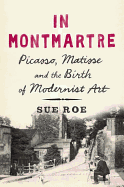
| Publisher: | Penguin Press | |
| Genre: | Art, History, Biography & Autobiography, Artists, Architects, Photographers, Modern (Late 19th Century to 1945) | |
| ISBN: | 9781594204951 | |
| Pub Date: | April 2015 | |
| Price: | $29.95 |
| Biography & Memoir |
by Sue Roe
Sue Roe's In Montmartre: Picasso, Matisse and the Birth of Modernist Art looks at that early 20th-century bohemian village atop a hillside overlooking Paris. Montmartre inspired many artists with its acrobats, dancers, prostitutes, clowns, cafes, cabarets and the ever-lively Moulin de la Galette. As Roe (The Private Lives of the Impressionists) demonstrates in this captivating work of art history, the "real revolution" of modern art took place there, "quietly and intimately, in the shadow of the windmills."
Roe begins in October 1900, when 19-year-old Pablo Picasso visited the World's Fair in Paris to see the city, the art and his own painting, Last Moments, on display. After trips back and forth to Spain, he moved to Montmartre and established friendships with dealers. The burgeoning iconoclastic atmosphere there challenged him to take risks, and several years later he painted his shocking Les Demoiselles d'Avignon--"nothing like it had ever been seen before." Over the course of a decade, the creative mecca of Montmartre gave birth to many schools of art--Fauvism, Cubism and Futurism--all contributing to the "heady sense of interconnectedness" felt by artists Henri Matisse, Georges Braque, Henri Rousseau, Maurice Utrillo, Amedeo Modigliani and Constantin Brâncusi. Others helped: together with her collector brother Leo and her nightly salons, Gertrude Stein had a huge impact, financially and aesthetically, on the artists.
Roe does a terrific job of showing how these painters, as well as fashion designers, dancers, photographers and filmmakers, influenced each other, excited by what they were creating. Like her own book, it was a "dynamic, entertaining drama." --Tom Lavoie, former publisher
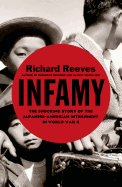
| Publisher: | Holt | |
| Genre: | United States, State & Local - West, Ethnic Studies, History, Social Science, 20th Century, World War II, Military, Asian American Studies | |
| ISBN: | 9780805094084 | |
| Pub Date: | April 2015 | |
| Price: | $32 |
| History |
by Richard Reeves
During World War II, the government forced tens of thousands of people to leave their homes and relocate to concentration camps surrounded by barbed wire and machine gun towers. While it may sound like Nazi Germany, Richard Reeves's Infamy: The Shocking Story of the Japanese American Internment in World War II details a dark chapter from United States history: the internment of more than 100,000 Japanese Americans in relocation camps.
"This is an American story of enduring themes: racism and greed, injustice and denial--and then soul-searching, apology, and the most American of coping mechanisms, moving on," he writes. The Japanese attack on Pearl Harbor came at a time when many Americans already mistrusted Asian immigrants. Government and military officials considered anyone of Japanese descent naturally devious. U.S. naval officials used Japanese Americans living in coastal California and Hawaii as scapegoats, claiming they were aiding the Japanese navy by transmitting secret signals. With public opinion in favor of relocation, Japanese Americans went quietly, even though the majority of them were American-born citizens.
Reeves (The Kennedy Years) sheds light on the climate and personalities that allowed such a major infringement of rights to occur on American soil. Absorbing and frequently heartrending, his narrative shifts among players in the global theater to first-person accounts of families who were forced to trade their homes for makeshift barracks. Incredible acts, courageous and villainous, pepper this history. Through it all, readers will wonder if the U.S. could stumble into such a mistake again, and if minorities today would fare any better. --Jaclyn Fulwood, blogger at Infinite Reads
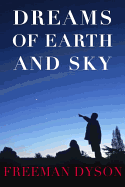
| Publisher: | New York Review Books | |
| Genre: | Essays, Science | |
| ISBN: | 9781590178546 | |
| Pub Date: | April 2015 | |
| Price: | $27.95 |
| Science |
by Freeman Dyson
A great popularizer of all things scientific, Freeman Dyson (The Scientist as Rebel) collects 21 pieces--previously published in the New York Review of Books--into Dreams of Earth and Sky. The essays exhibit Dyson's ability to distill difficult subjects into a parlance most readers will understand, as well as cheerful admissions that he may be wrong. But he prefers being "politically incorrect and provocative," as illustrated by his belief that modern calculations of global warming are incorrect.
Fans of the TV show Manhattan will find his piece about Robert Oppenheimer of particular interest. Oppenheimer was "astonishingly effective as leader of the Los Alamos project" and "never regretted his role as the chief architect of the [hydrogen] bomb," Dyson writes. While Oppenheimer preferred the Army's tactical weapons rather than the Air Force's desire for the H-bomb, he went along with the Air Force because he "understood that the project was not scientific but military." Dyson thinks Winston Churchill "was in love with war and weapons, ever since he was a small boy." He describes Einstein and Hawking as "two scientific superstars," with Carl Sagan, Neil deGrasse Tyson and Richard Dawkins as "lesser lights"; Richard Feynman is "rising to the status of superstar," thanks largely to his significant contributions as a member of the Challenger commission.
In "Our Biotech Future" Dyson predicts that the "domestication of biotechnology will dominate our lives during the next 50 years at least as much as the domestication of computers has dominated our lives during the previous 50." This is what makes Dyson so interesting to read: he's witty and sage--and opinionated. --Tom Lavoie, former publisher

| Publisher: | Harper Design | |
| Genre: | Literary Collections, Art, General, Essays, Subjects & Themes, Portraits, Popular Culture, Photography | |
| ISBN: | 9780062334428 | |
| Pub Date: | April 2015 | |
| Price: | $29.99 |
| Starred | Art & Photography |
by Melissa Ann Pinney, edited by Ann Patchett
"I've always been interested in watching people together. I wonder what their story is, who they are to each other," explains photographer Melissa Ann Pinney in Two, a collection of more than 90 color images that focus on pairs of people and objects, accompanied by 10 essays by notable contemporary writers.
In this group of vivid, often mystical and playful images, Pinney explores connection, identity and relationships. There is a candid aesthetic to her work. Even her posed photographs grant viewers a glimpse into lives-in-action: a couple's embrace; a tender moment between mother and child; two nested teacups; a girl and her obedient dog; two barefoot, suspender-wearing Amish men staring into a placid sea; an elderly man having his hair done poolside.
The accompanying essays, which delve into the nature of pairs and twosomes, make the book even more compelling. Edwidge Danticat writes about having her feet washed by a stranger in church. Barbara Kingsolver expresses her feelings of being left out of the "charmed Romeo-Julietness" of her parents' marriage. Maile Meloy explores, with awe, the 70-year bond between her grandparents. Allan Gurganus considers the possibility of vanishing twin syndrome, and Elizabeth McCracken writes about her mother's enduring bond with her fraternal twin.
In the moving, eloquent opening essay, Ann Patchett notes that writers and photographers share a similar drive to exist "alone and in the world" in order to create their art. That concept makes Patchett and Pinney's collaborative exploration into the "the power of two" all the more thought-provoking. --Kathleen Gerard, blogger at Reading Between the Lines
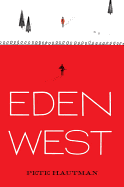
| Publisher: | Candlewick | |
| Genre: | Friendship, Adolescence, Social Issues, Other, Juvenile Fiction, Religious | |
| ISBN: | 9780763674182 | |
| Pub Date: | April 2015 | |
| Price: | $17.99 |
| Starred | Children's & Young Adult |
by Pete Hautman
In Eden West, Pete Hautman plumbs the depths of faith and doubt through the eyes of 17-year-old narrator Jacob, who finds himself questioning the sanctity of his religious community.
Jacob, walking the perimeter of Nodd's 12 square miles of paradise, comes face to face with a worldly girl on the other side of the fence. She calls him "Cult Boy" and introduces herself as Lynna. Her laugh makes him think of "bells wrapped in velvet," and the thin fabric of her black T-shirt "does nothing to conceal the shape of her breasts." Suddenly, Jacob is dreaming of both Lynna and Sister Ruth, the young woman he always thought he would be with until Zerachiel comes to take the pure of heart onto the Ark.
Probing themes he explored in Godless, Hautman reveals the inner struggle of a young man as the scales begin to fall away from his eyes. Jacob strikes up a forbidden friendship with Lynna and begins to see Father Grace and his followers through her eyes. His view widens to include the world beyond Nodd's fences. When Tobias, a newcomer, arrives in Nodd, and again when Lynna, in crisis, seeks sanctuary there, Jacob shows the most compassion and realizes that Father Grace does not always practice what he preaches.
In this novel that cuts to the core of adolescence, Hautman walks the line between those of pure faith and those who stray, creating full-blooded characters who feel real and flawed. Jacob must sort out his own relationship with the God of his understanding--no one can teach him what that looks like. --Jennifer M. Brown, children's editor, Shelf Awareness
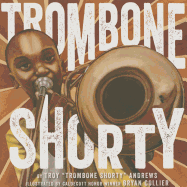
| Publisher: | Abrams | |
| Genre: | People & Places, Juvenile Nonfiction, Jazz, Biography & Autobiography, Music, United States - African-American | |
| ISBN: | 9781419714658 | |
| Pub Date: | April 2015 | |
| Price: | $17.95 |
| Children's & Young Adult |
by Troy Andrews, illust. by Bryan Collier
Author-musician Troy Andrews recounts the origins of his nickname and his rise to musical prominence in Trombone Shorty. Pen-and-ink, watercolor and collage illustrations from Bryan Collier (I, Too, Am America) bring to life both the musician and New Orleans, the city that shaped him.
"Where y'at?" swirls over a whirl of notes emanating from young Troy's trombone in Collier's triptych of opening images. In New Orleans, "that's what we like to say when we want to tell a friend hello. So. Where y'at?" Andrews speaks of growing up in Tremé, with "music floating" all day long. Collier hints at a bustling city neighborhood with traffic lights on the corner; the encircled letters of Tremé imitate trumpet finger buttons, and echo balloons that float like music notes. Troy's big brother James played trumpet and led his own band. Troy loved Mardi Gras, when the brass bands would parade past his house. "People didn't have a lot of money in Tremé, but we always had a lot of music," he writes. One day, he found a broken trombone and began to play. "Trombone shorty!" James called out, "because the instrument was twice my size!" Troy's big break comes when Bo Diddley pulls the boy onstage after hearing his notes from the audience. Collier pictures him as an adult musician playing in a hot air balloon, powered by his music, floating over Paris.
Trombone Shorty models hard work and discipline. He taught himself to play, and practiced "day and night." Today, he encourages young musicians, just as James did for him. --Jennifer M. Brown, children's editor, Shelf Awareness
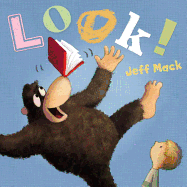
| Publisher: | Philomel/Penguin | |
| Genre: | Animals, Juvenile Fiction, Humorous Stories, Apes, Monkeys, etc., Books & Libraries | |
| ISBN: | 9780399162053 | |
| Pub Date: | April 2015 | |
| Price: | $16.99 |
| Children's & Young Adult |
by Jeff Mack
With only two words, Jeff Mack's (Ah Ha!) primarily visual narrative shows how books bring us together in ways that technology cannot.
A gorilla enters, scratching its head with the left hand while holding a blue book in the right. Then the gorilla tries wearing the book, and taps the back of a blond boy engrossed in a television program: "Look," says the gorilla. The child ignores the furry creature. The gorilla balances the book on its nose ("Look Look") while waving an arm in front of the TV screen. The child bats the gorilla away and introduces the volume's second word: "Look out." Mack distinguishes who says what by representing the gorilla's words in crayon, and the boy's words in an array of type fonts that emulates collage. As the gorilla's antics grow wilder, the child grows increasingly annoyed ("Look out!," the boy cries). A mishap while juggling books on a tricycle ends with the gorilla destroying the television. Mack creates a two-page spread with a lifelike reproduction of a page that's been torn to reveal the red-faced boy shouting "Out! Out! Out!" After the gorilla exits, the child strikes a pose similar to the one the gorilla opened with, staring at a red book and scratching his head. The gorilla sheepishly returns, and the boy, with the book open, invites the gorilla in with "Look."
While the gorilla saw the book as an attention-getting prop, the boy's desire to share what he finds within its pages brings them together. Ideal for beginning readers and storytime. --Jennifer M. Brown, children's editor, Shelf Awareness